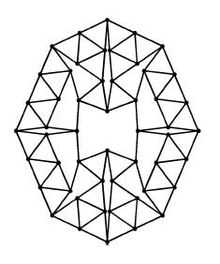Matchstick graph

In geometric graph theory, a branch of mathematics, a matchstick graph is a graph that can be drawn in the plane in such a way that its edges are line segments with length one that do not cross each other. That is, it is a graph that has an embedding which is simultaneously a unit distance graph and a plane graph. Informally, matchstick graphs can be made by placing noncrossing matchsticks on a flat surface, hence the name.[1]
Regular matchstick graphs
Much of the research on matchstick graphs has concerned regular graphs, in which each vertex has the same number of neighbors. This number is called the degree of the graph.
It is known that there are matchstick graphs that are regular of any degree up to 4. The complete graphs with one, two, and three vertices (a single vertex, a single edge, and a triangle) are all matchstick graphs and are 0-, 1-, and 2-regular respectively. The smallest 3-regular matchstick graph is formed from two copies of the diamond graph placed in such a way that corresponding vertices are at unit distance from each other; its bipartite double cover is the 8-crossed prism graph.[1]
In 1986, Heiko Harborth presented the graph that would bear his name, the Harborth Graph. With 104 edges and 52 vertices, is the smallest known example of a 4-regular matchstick graph.[2] It is a rigid graph.[3]
It is not possible for a regular matchstick graph to have degree greater than four.[4]
The smallest 3-regular matchstick graph without triangles (girth ≥ 4) has 20 vertices, as proved by Kurz and Mazzuoccolo.[5] Furthermore, they exhibit the smallest known example of a 3-regular matchstick graph of girth 5 (180 vertices).
Computational complexity
It is NP-hard to test whether a given undirected planar graph can be realized as a matchstick graph.[6][7]
Combinatorial enumeration
The numbers of distinct (nonisomorphic) matchstick graphs are known for 1, 2, 3, ... up to nine edges; they are:
References
- ↑ 1.0 1.1 Weisstein, Eric W., "Matchstick graph", MathWorld.
- ↑ Harborth, Heiko (1994), "Match sticks in the plane", in Guy, R. K.; Woodrow, R. E., The Lighter Side of Mathematics: Proceedings of the Eugéne Strens Memorial Conference of Recreational Mathematics and its History, Calgary, Canada, 1986, Washington, D.C.: Mathematical Association of America, pp. 281–288. As cited in: Weisstein, Eric W., "Matchstick graph", MathWorld.
- ↑ Gerbracht, E. H.-A. (2006), Minimal polynomials for the coordinates of the Harborth graph, arXiv:math.CO/0609360
- ↑ Kurz, Sascha; Pinchasi, Rom (2011), "Regular matchstick graphs", American Mathematical Monthly 118 (3): 264–267, doi:10.4169/amer.math.monthly.118.03.264, MR 2800336.
- ↑ Kurz, Sascha; Mazzuoccolo, Giuseppe (2010), "3-regular matchstick graphs with given girth", Geombinatorics 19: 156–175.
- ↑ Eades, Peter; Wormald, Nicholas C. (1990), "Fixed edge-length graph drawing is NP-hard", Discrete Applied Mathematics 28 (2): 111–134, doi:10.1016/0166-218X(90)90110-X.
- ↑ Cabello, Sergio; Demaine, Erik D.; Rote, Günter (2007), "Planar embeddings of graphs with specified edge lengths", Journal of Graph Algorithms and Applications 11 (1): 259–276.
- ↑ Salvia, Raffaele (2013), A catalog for matchstick graphs, arXiv:1303.5965